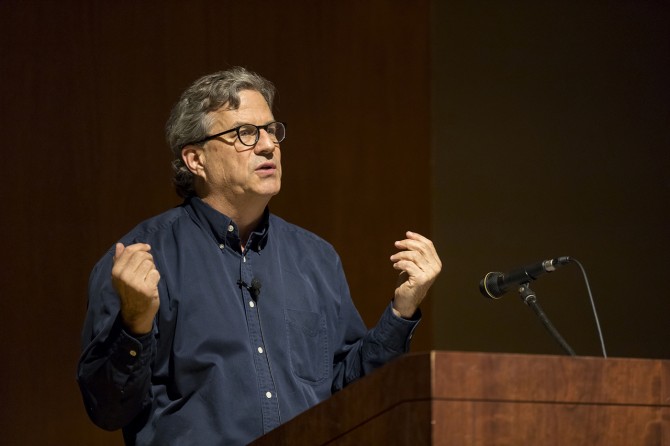Reporter paints vivid portrait of opioid epidemic
By Stephen D'Angelo
“Opiates are the poster drugs of our time, our culture today, an age dominated by isolation, by fleeting connections, by social media and 24-hours-a-day news, by ideological dogma forcing us into these little bubbles,” said National Book Critics Circle Award-winning journalist Sam Quinones on the origins and impacts of the opioid epidemic Nov. 7 at Call Auditorium.
A former reporter for the Los Angeles Times who has covered immigration, drug trafficking and gang violence, Quinones spoke on his most recent nonfiction book, “Dreamland: The True Tale of America’s Opiate Epidemic.”
Quinones painted a vivid picture of the epidemic that covered not only the rise of drug cartels, but also the medical, cultural and economic factors that stoked the epidemic’s flames and scourged families across the country.
Replacing traffickers from the Far East, drug cartels in Latin America began to become extremely effective and efficient during the 1980s, becoming responsible for 100 percent of heroin distribution in the U.S., he said. At the same time, the prescription pain killer Fentanyl, a narcotic derived from the poppy, was becoming more widespread in general medical practice and treatment.
“What we also experienced in the beginnings of that decade was a revolution in pain management in American medicine,” he said, explaining that pain doctors at the time wanted to leverage these drugs as tools to cure pain, with no science to back up claims that they were not addictive. “[Doctors] believed it was almost their medical duty to get more and more doctors using these drugs to resolve patients’ pain … and they were joined by pharmaceutical firms who they viewed at allies.”
According to Quinones, this was accompanied by a shift in cultural self-perception that Americans are entitled to a life free of pain. This was intensified by blockbuster drugs that could solve health problems without a patient taking responsibility for their choices.
“We wanted convenience, easy, we wanted a quick fix, we wanted to go into a doctor’s office and be seen, diagnosed and cured that day,” Quinones said. “So if you ate poorly, there was a blockbuster drug for cholesterol or hypertension … we got trained as a culture in America that we were exceptional and that there was a solution to all of our problems, and when it came to pain and health – that usually came in the form of a pill,” rather than the hard work of changing one’s diet or increasing exercise.
When OxyContin was made available in the mid-1990s, advertised to patients as the ultimate nonaddictive cure for pain, it was a game-changer. This was further exacerbated by a revolution in the pharmaceutical sales industry, that Quinones described as an arms race.
Those addicted to OxyContin, but unable to afford their daily habit, saw cheaper heroin as a “no-brainer alternative.” Mexican drug cartels saw the opportunity and began trafficking heroin to opioid addicts.
Quinones argued that a primary root of the problem was that America had spent the last 35 years destroying community across the country. It had chased factories out of town, demolished mom-and-pop shops on Main Street and settled for cheap goods from big box stores. Further, neighborhoods and parks became vacant as parents kept their children indoors fearing they would get hurt, and people lived more protected, isolated lives.
“Yet, this epidemic might be forcing upon us the opposite effect that it has on users,” Quinones said. “It may be forcing on us a return to nuance, to empathy, to discovery of common ground with others we didn’t think we had anything common with.
“Understanding that it is reliance on each other through community, which we’ve done so much to destroy, that we will most likely find our way out of this very dark storm. I have faith in my country that on that path lie the solutions.”
The lecture was made possible through the support of Jennifer Koen-Horowitz ’93 and Mark Horowitz and co-sponsored by the College of Human Ecology, the Department of Policy Analysis and Management, the Sloan Program in Health Administration and the Cornell Institute for Public Affairs.
Stephen D’Angelo is Assistant Director of Communications at the College of Human Ecology.
Media Contact
Get Cornell news delivered right to your inbox.
Subscribe

